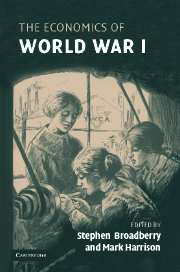Book contents
- Frontmatter
- Contents
- List of figures
- List of tables
- List of contributors
- Acknowledgements
- Introduction
- 1 The economics of World War I: an overview
- 2 The pity of peace: Germany's economy at war, 1914–1918 and beyond
- 3 Austria-Hungary's economy in World War I
- 4 The Ottoman economy in World War I
- 5 Between the devil and the deep blue sea: the Dutch economy during World War I
- 6 Was the Great War a watershed? The economics of World War I in France
- 7 The United Kingdom during World War I: business as usual?
- 8 Poor Russia, poor show: mobilising a backward economy for war, 1914–1917
- 9 Italy at war, 1915–1918
- 10 Until it's over, over there: the US economy in World War I
- Index
- References
10 - Until it's over, over there: the US economy in World War I
Published online by Cambridge University Press: 23 July 2009
- Frontmatter
- Contents
- List of figures
- List of tables
- List of contributors
- Acknowledgements
- Introduction
- 1 The economics of World War I: an overview
- 2 The pity of peace: Germany's economy at war, 1914–1918 and beyond
- 3 Austria-Hungary's economy in World War I
- 4 The Ottoman economy in World War I
- 5 Between the devil and the deep blue sea: the Dutch economy during World War I
- 6 Was the Great War a watershed? The economics of World War I in France
- 7 The United Kingdom during World War I: business as usual?
- 8 Poor Russia, poor show: mobilising a backward economy for war, 1914–1917
- 9 Italy at war, 1915–1918
- 10 Until it's over, over there: the US economy in World War I
- Index
- References
Summary
Introduction
This chapter re-examines the financial and economic history of the United States during World War I. It focuses on economic policy: on what policy makers did, and equally important on what conclusions they drew from the short and confused experience of America's involvement in World War I. The first section, on the war boom, presents the chronology of American involvement, and contrasts the World War I expansion with previous expansions. (A list of key dates is contained in the appendix to this chapter.) The second section describes how resources were mobilised and allocated to the war sector. The third section on the financing of the war, is divided into three parts: monetary policy, fiscal policy (taxes), and debt policy. The fourth section discusses the War Industries Board and other government agencies that were charged with regulating prices and production. The fifth section discusses the production of munitions. The concluding section, on the legacies of the war for the United States is divided into three parts: the costs of the war in terms of resources, the impact of the war on the role of the United States in international capital markets, and the institutional and ideological legacies of the war.
The war boom in historical perspective
The outbreak of the war in Europe in 1914 touched off a severe financial disturbance in the United States.
- Type
- Chapter
- Information
- The Economics of World War I , pp. 310 - 343Publisher: Cambridge University PressPrint publication year: 2005
References
- 11
- Cited by

